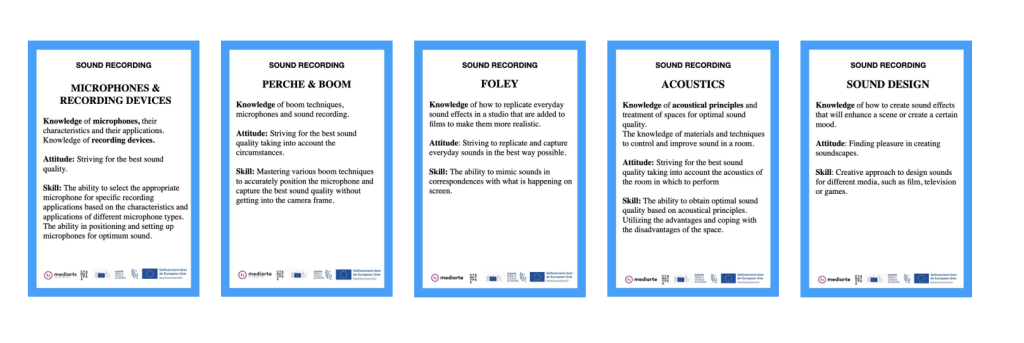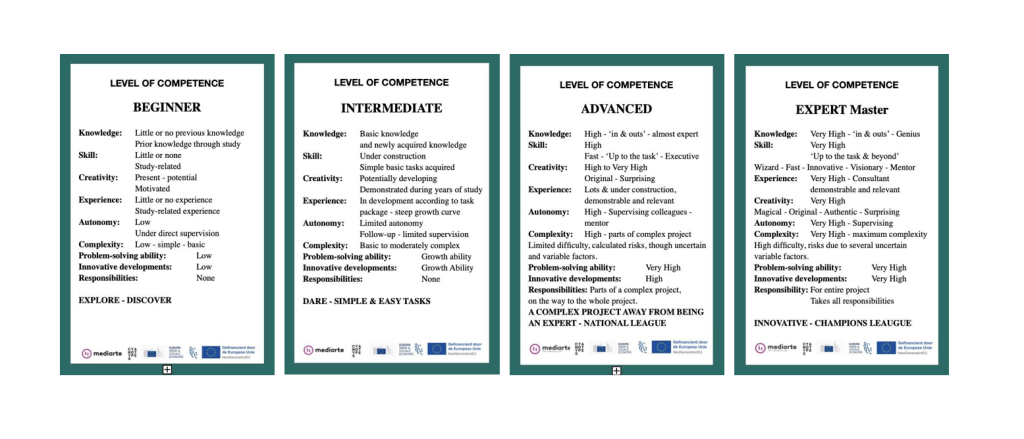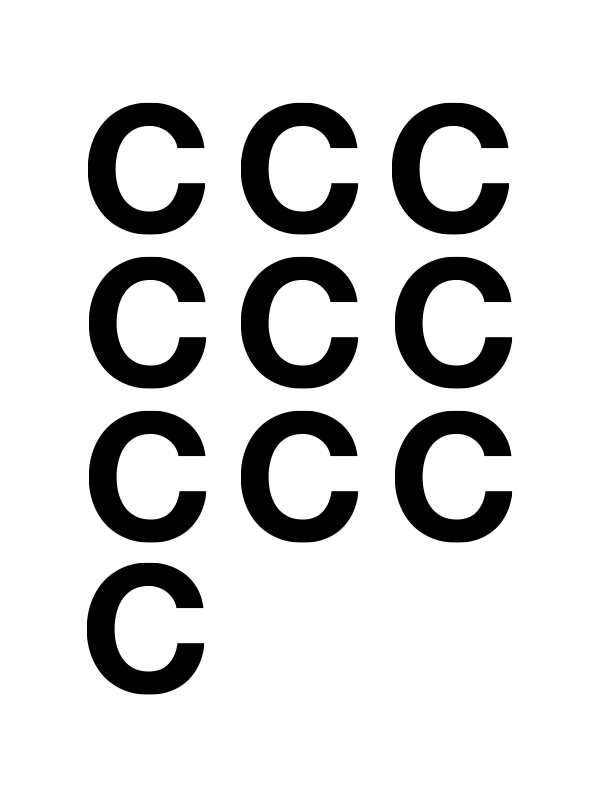The Competence Collector
17 min read

CheckIt, the toolkit
In november 2023, mediarte – the social fund of the audiovisual sector in Belgium – assigned me the operational lead in the European financed CheckIt-project. The aim is to screen audiovisual companies for competences present and detecting which training could be offered to become more competent. When I asked what toolkit I could use, the answer was short: “There is no toolkit”. That was the best answer I could get. I always loved to develop course material and the absence of a toolkit offered me the opportunity to build a new one.
The online Dictionary.com refers to a toolkit as “a collection of tools or other useful equipment typically kept in a box or a case”. Reference is usually made to the carpenter’s toolbox and most of the time to the toy toolbox including a hammer, a saw, a screwdriver, a spanner and a folding ruler. Five tools. We’ll come back to that later.
A toolkit is also “a collection of expert skills, knowledge, procedures, or information for a particular topic or activity.” According to the American Library Association “toolkits are meant to offer practical advice and guidance regarding an issue of concern or importance.” Numerous toolkits are available: a toolkit for Libraries of course, a toolkit for Emotions, a toolkit for Effective Everyday Activism, a toolkit for Modern Life, a toolkit for Aging Gracefully, a toolkit for Sustainable Travel, a toolkit for Design Thinking and even Toolkit Guides on How to Build a Toolkit. How disappointing to find out that a lot of those toolkits end up offering an ordinary spreadsheet. Most importantly, numbers on a spreadsheet aren’t supposed to talk back. We risk becoming walking spreadsheets, as Professor of Organisation Studies Peter Fleming notices in his book Dark Academia (2021), referring to the words of New Zealand singer and songwriter Lorde: ‘I’m not a spreadsheet with hair!’.
CYANOTYPES, an international partnership
Meanwhile, mediarte had become a partner in CYANOTYPES, a wide variety of international organisations, brilliant stakeholders, and incredibly interesting European networks to address the skills needed in the Cultural and Creative Industries. The first year of our partnership I listened carefully to all the overwhelming presentations, took notes during well mastered workshops, tooled around and kitted myself out to absorb all the new, complex but definitely enriching information.

After a mid-term review presentation in Brussels, submitting the results of the literary research and the outcomes of several inspiring workshops, I was relieved to notice that I understood most of what had been said, while for those who were for the first time confronted with this overload of information, had lots of question marks popping up in their eyes. The fact that there was not yet a common language of competences became clear. Try for instance to explain the difference between transversal, transformational and transformative competences. You definitely get in a kind of trance.
As the Swedish proverb says “a loved child has many names”, one competence is many worlds. Confronted with different names, perspectives, different associations, connotations and interpretations, I realised the descriptions of the competences had to be crystal clear, simple, easy to understand and straightforward, eliminating the slightest confusion. No academic language, avoiding long sentences, no difficult words.
Just do it
Time was not on my side because I had only a couple of months to deliver a toolkit and start screening companies. Instead of following the advice of Einstein to spend most of the time thinking about the problem and 5 minutes thinking about solutions, I followed the tagline of a notorious sportsbrand: Just do it. Or as a former President of the United States stated: Just get stuff done.
As the aim of the CheckIt project was to screen audiovisual companies in Belgium for competences present, I had to start collecting competences. And fast. To store all the data, I had to spread a sheet. I had to accept that a spreadsheet is a useful tool to collect all the competences and their descriptions.
Luckily CYANOTYPES was like an orchard full of low-hanging fruit. The sharing of knowledge is one of the characteristics of CYANOTYPES. Caroline van Leuven, project manager of CYANOTYPES, suggested to me
to refer to a competence as a combination of knowledge, attitude and skill, to avoid the term soft skills and to add a precise description of those three components for each competence.
EQ-Arts, enhancement-led quality assurance (QA) for higher arts education, presented in a workshop the competence framework for “Innovative Policymaking”, an elaborate and impressive tool. The overview of the 7 competence clusters provided a lot of useful information with detailed descriptions in terms of attitudes, knowledge and skills. I stood at the foot of a mountain that only grew taller and taller by every competence I read. I felt blown away when I realised I had to adapt the descriptions to the audiovisual sector. Again I was confronted with the given that one competence has many words referring to many worlds.
Mapping competencies, embracing complexity
During an online workshop of CYANOTYPES, all the partners were asked to dig out transversal competences and add them on a MIRO board, attributing them into 4 categories: Transformative skills, Green skills, Entrepreneurial skills and Digital skills. Senior Training Manager at Materahub Gabriella Antezza guided this delicate process, shifting sticky notes, rearranging, deciding which competence belonged to which skillbox, organising clusters, listening to suggestions and arguing why a competence belonged to a cluster and not to another cluster, turning three words into one competence, changing names, resolving issues. With an imperturbable patience, focused and decisive, she succeeded in mapping out a first draft of competences belonging to the creative and cultural sector. This amazing work helped me in formulating competences for the audiovisual sector.
Embracing Complexity became one of my favourite competences. Whereas complexity is normally something people try to avoid, to escape or to solve, embracing on the other hand, suggests an active, positive and human attitude towards it. The paradox calls for creativity, knowledge, coping with uncertainty, authority and humbleness. So I embraced the complexity of my toolkit.
The more time and research I put into collecting competences, the more I discovered the beauty of describing a word, the poetry of a competence, the positivity hidden in a competence. Little by little I became a competence collector. Collecting worlds in words.
Now that I had a huge collection of competences in a digital spreadsheet, it was about time to build an analogue toolkit. I was looking for something tangible, something that you can hold and look at and that can start a conversation, as I wanted a dialogical approach.
“Dialogical approach is a way of thinking together with other people to find new solutions and possibilities to act in worrying situations, development processes, complex and wicked problems (European Dialogical Toolkit/Project Results 3).”
An obvious solution presented itself. As a child, I loved to play the quartet card game. Trying to complete a set of four cards. Carbon cards with competences, with the idea of completing a set of competences
were the next step. These sets of carbon cards would serve as ‘dialogue starters’, a term I borrowed from Koen Marichal, founder and inspirer of Antwerp Management School’s Leadership Expertise Centre.

Willem-Jan Renger’s playful gamification
Willem-Jan Renger, Designer Creative Transformations & Playful Learning at HKU, expert in gamification and David Crombie, Program Manager of CYANOTYPES, had heard about my toolkit-under-cunstruction and invited me to Utrecht to present the cards and clarify my approach. I was aware of the fact that a solid methodology was still missing in the toolkit and I hoped to find the missing link in Utrecht.
My cards lay silently on a table, in chaos, staring back at us. It felt as if I had to defend my master thesis. Convinced of the potential, uncertain of the outcome.
Willem-Jan was impressed by the amount of cards, but the compliment instantly became the weakness of my approach. Too many cards and even more cards to come. The taxonomy was not correct. I had departed from assigning competencies to specific audiovisual functions such as sound engineer, camera operator and creative producer, which would require me to recreate the same cards but slightly modified, for new functions, creating an expanding galaxy that would become unmanageable. Brain freeze. I was sent back to the drawing board.
I hoped Willem-Jan would unlock the taxonomy, give me the ultimate answer, and tell me what to do. None of this. Triple loop learning needs three loops. Not an easy shortcut. As a true mentor he showed me the direction, but the journey was mine. I hate – but no longer than for 3 seconds – those kinds of mentors. But in the end he meant, Gandalf-like: “I know you’ll figure it out”. Everyday offers the chance to start all over again. Not all over again, but stop ‘just do-ing it’ and start thinking again. Doing the thinking I should have done before the doing. Being Einstein. Rethinking some things and redoing. Discovering that the former president of America had said: “Start learning to get stuff done“ instead of “just get stuff done”.
In a triple loop modus I changed the taxonomy. I would no longer mention a specific function such as sound engineer or camera operator, but I would start from IMAGE and SOUND. Both elements would include REGISTERING and EDITING. Suddenly, I could create clusters like SOUND RECORDING, SOUND EDITING and SOUND TECHNIQUE. It opened the door to clusters around CREATIVITY and IDEA DEVELOPMENT which are also competences of a sound engineer.

Still, I counted a lot of competences but the more I worked on this method, the more this method seemed to work. The new universe became manageable, thinned out and turned out to have an awful lot of potential. I felt like a true Guardian of the Galaxy, protecting the competence galaxy against implosion.
Matera’s 5 competences, a quintet
In June, I participated in the workshop to test and validate the CYANOTYPES Train-the-Trainer Framework, part of the Creative Agency Circle, organised by Materahub and the University of Applied Arts Vienna, partners of CYANOTYPES in Matera. I wrote about the workshop in a previous article.
Matera turned out to be an important part of my journey in search of a methodology. Pieces fell together. The well-tuned Materahub duo Gabriella Antezza and Becky Riches, assisted by Angelika Zelisko and Ragnheiõur Erla Björnsdóttir, explained in an understandable way the CYANOTYPES Framework and referred several times to the five competencies for each main competence, in order to limit the amount of competences.
The carpenter’s toy toolbox with only 5 tools revisited me. Finally it dawned on me that I had to organise my own framework using the same system CYANOTYPES was using: a main competence and using only 5 sub-competences for each main competence. I still wonder why I hadn’t seen this in an earlier phase.
This insight forced me to make new clusters and reattribute the most relevant and usable competences to a cluster. For instance, Paper Chase would become the main competence with 5 sub-competences: 1. Contracts&Agreements, 2. Production Bible, 3. Permits&Authorisations, 4. Financing&Funding, 5.
Reporting. Well done Gromit. Thank You Gabriella.
These 5 relevant sub-competences, which are still clusters of different competences, could effectively be used in the screening of a production company for multiple functions. These competences are important for both a line-producer, a creative producer, a production-assistant, an executive producer, a production manager, a production accountant and a location manager. The carbon card universe stopped exploding and expanding.
Meanwhile I was offered the opportunity to present my toolkit during the Creative Skills Week in Amsterdam. I wrote to Barbara Revelli, Head of Programmes at ELIA, the leading network organisation for higher arts education in Europe and beyond: “I still have no methodology!” Although the cards are very useful as dialogue starters, a clear and well-founded methodology is still missing. Help!
Competence levels
While writing the article on the Matera workshop, I remembered that Gabriella had mentioned competence levels, referring to the Entrepreneurship Competence Framework (EntreComp). EQ-Arts also emphasised the importance of competence levels. And suddenly a very simple methodology dawned and revealed itself. Imagine drums and music of Hans Zimmer accompanying this moment. I needed to add levels. I started with 8 levels, but that was too complex. I unembraced this complexity and brought it down to beginner, intermediate, advanced and expert level. That would be more adequate. I added criteria to determine the level: autonomy of work, assumption of responsibilities, complexity of a project, problem-solving ability, innovative skills.

Suddenly, it became possible to discuss the level of a competency and ascertain what training would be relevant to grow to a required level, if needed and desired. A methodology was born. The card universe found some order. The cards became even more than only dialogue starters, they became dialogue facilitators. It looked too simple to be true. But Willem-Jan reassured me, simple is the best. Simple does not precede complexity, it follows it. After embracing complexity, I now embrace simplicity.
Training in the audiovisual sector
I learned a lot about how people in an audiovisual production company learn, unlearn, relearn and become more competent. My analysis of a very competent audiovisual sector, characterised by a strong learning culture, delivered a new set of cards which I could use to visualise the learning steps to grow and become more competent. I noticed that employees take the initiative themselves and do a lot of self-study. They watch tutorials and look things up on the web. On-the-job training ensures a steep learning curve. Informal knowledge sharing while sharing a coffee during a break provides new insights and the necessary information to solve small problems and make quick fixes. Moving from a complex project to a more complex project seems to be a very important pathway to become an expert. When necessary and possible, external training and masterclasses are provided.
The competence cards facilitate amazing conversations. During my screenings of companies and the conversations I had with employers and employees, I’ve met so many competent artists, wonderful craftsmen and -women, talented beginners and humble experts, entrepreneurial managers, brilliant sound engineers, marvellous camera operators, creative creative-producers, in-the-blink-of-an-eye editors, …
Validation in Amsterdam
A week before the Creative Skills Week in Amsterdam, with the help from CYANOTYPES friends, I had a set of cards, a toolkit with a methodology and less stress to tell my real-life story from the – audiovisual – field. Willem-Jan introduced me, in a most kind way, and the people in the room were open, attentive and responded positively after the presentation, which was a relief. The methodology was validated, the framework accepted, the toolkit welcomed. The toolkit, according to some people, could be used in other workshops, in different contexts and in developments alike. Beyond my expectations.
I hope my toolkit is a valuable contribution to the development of the CYANOTYPES Train-the-Trainer Framework, because CYANOTYPES was a huge contribution to my framework. The toolkit is work in progress, a blueprint that will be continuously revised and updated. We are all CYANOTYPES.
Geert Genbrugge

